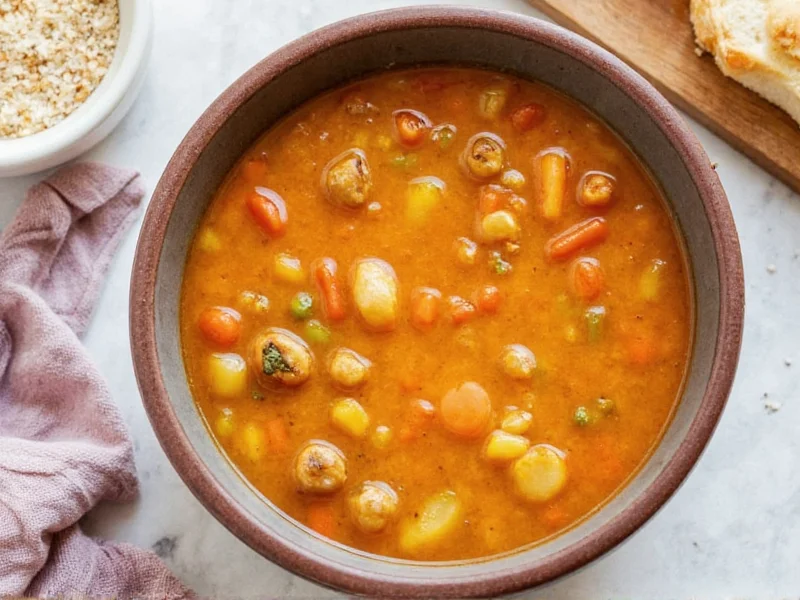Why Crockpot Soups Transform Weeknight Cooking
Slow cooker soups solve the universal dinner dilemma: how to create nourishing meals with minimal effort. Unlike stovetop versions, crockpot soup ideas leverage low-temperature, long-duration cooking that tenderizes tough cuts of meat and melds flavors naturally. The magic happens while you work, sleep, or run errands—simply prep ingredients in the morning, and return to a fully developed meal. This hands-off approach makes easy crockpot soup recipes for beginners particularly valuable for busy households.
Essential Techniques for Perfect Crockpot Soups
Achieving restaurant-quality results requires understanding slow cooker dynamics. Unlike pressure cookers, crockpots operate at lower temperatures (typically 175-200°F on low setting), which affects ingredient timing. Critical techniques include:
| Ingredient Type | Optimal Addition Time | Why It Matters |
|---|---|---|
| Meats (beef, chicken) | Start of cooking | Allows collagen breakdown for tender results |
| Root vegetables | First 2 hours | Prevents mushiness while ensuring tenderness |
| Leafy greens | Last 30 minutes | Maintains texture and vibrant color |
| Dairy products | After cooking cycle | Prevents curdling from prolonged heat |
Seasonal Crockpot Soup Rotation Guide
Adapting your best crockpot soup recipes for winter versus summer maximizes flavor and nutritional benefits. Seasonal produce not only tastes better but often costs less. Consider this strategic rotation:
- Winter: Hearty beef stew with red wine, creamy potato leek, and white bean soup with kale—ideal for cold months when warming, substantial meals satisfy
- Spring: Asparagus and pea soup, light chicken orzo soup, and artichoke lemon soup that celebrate fresh, tender vegetables
- Summer: Chilled gazpacho, fresh tomato basil, and corn chowder that use peak-season produce without heating your kitchen
- Fall: Butternut squash apple, mushroom barley, and pumpkin lentil soups that complement autumn harvests
Dietary Adaptation Strategies
Creating vegetarian crockpot soup recipes that satisfy meat-eaters requires strategic umami boosters. Replace meat-based stocks with:
- Miso paste dissolved in hot water
- Dried mushrooms steeped in broth
- Tomato paste caramelized before adding liquids
- Nutritional yeast for cheesy notes
For gluten-free versions, replace roux with cornstarch slurry added during the last 30 minutes. Dairy-free alternatives work best when added after the cooking cycle—coconut milk provides creaminess without curdling risks.
Time-Saving Meal Prep Framework
Implement these crockpot soup recipes with minimal prep strategies to reduce active cooking time to 15 minutes or less:
- Batch-Prep Components: Chop onions, carrots, and celery in bulk on weekends; freeze in portioned bags
- Freezer-Friendly Kits: Combine dry spices and herbs in small bags with recipe cards
- Protein Shortcuts: Use pre-cooked beans or frozen, pre-diced vegetables when time is critical
- Layering System: Place longer-cooking ingredients at the bottom, delicate items on top
This approach transforms make-ahead crockpot soup meals into a sustainable habit. Most soups freeze beautifully for 3-4 months—simply cool completely, portion into freezer bags (lay flat for space efficiency), and label with date and reheating instructions.
Troubleshooting Common Crockpot Soup Issues
Even experienced cooks encounter challenges with slow cooker soups. Here's how to fix frequent problems:
- Too watery: Remove lid during last 60-90 minutes of cooking to allow evaporation, or add 1-2 tbsp cornstarch slurry
- Bland flavor: Finish with acid (lemon juice or vinegar) and fresh herbs—slow cooking mutes bright notes
- Overcooked vegetables: Add delicate vegetables during last 2 hours; root vegetables can handle full cooking time
- Fat separation: Skim excess fat before serving, or use an immersion blender for emulsification
Building Flavor Depth Without Complicated Steps
The secret to exceptional family-friendly slow cooker soup recipes lies in strategic layering of flavors. Try these professional techniques:
- Dry sear meats: Pat proteins dry before browning—moisture prevents proper caramelization
- Sweat aromatics: Cook onions and garlic on stove until translucent before adding to crockpot
- Deglaze: Scrape browned bits from searing pan with wine or broth before adding to slow cooker
- Finish bright: Stir in fresh herbs, citrus zest, or a splash of vinegar just before serving
These methods create complex flavor profiles in budget-friendly crockpot soup ideas without requiring expensive ingredients or advanced skills. The slow cooking process naturally develops depth that would take hours of attention on the stovetop.
Frequently Asked Questions
Can I put raw meat directly into a crockpot for soup?
Yes, but for significantly better flavor, brown meats first. Searing creates Maillard reactions that develop complex flavors impossible to achieve through slow cooking alone. Ground meats should always be browned and drained to prevent greasy results.
How long can I safely leave soup in the crockpot after cooking?
Most soups remain safe for 2-4 hours on the 'warm' setting. After that, transfer to refrigerator storage. Never leave soup at room temperature for more than 2 hours. For meal prep, cool soup rapidly by placing the removable crockpot insert in an ice bath before refrigerating.
What vegetables hold up best in all-day crockpot cooking?
Root vegetables like potatoes, carrots, parsnips, and turnips maintain texture through extended cooking. Add softer vegetables like zucchini, peas, or spinach during the last 1-2 hours. Frozen vegetables work well added in the final hour—no need to thaw first.
How can I thicken crockpot soup without flour?
Blend 1-2 cups of the soup and return to the pot, use cornstarch slurry (1 tbsp cornstarch + 2 tbsp cold water per cup of liquid), or add pureed cooked beans or lentils. For cream-based soups, stir in coconut milk or pureed cauliflower near the end of cooking.
Is it safe to cook frozen ingredients in a crockpot?
Thaw meats completely before slow cooking to prevent them from lingering in the danger zone (40-140°F) where bacteria multiply rapidly. Frozen vegetables can go directly into the pot, but add them during the last 2-3 hours of cooking for best texture.











 浙公网安备
33010002000092号
浙公网安备
33010002000092号 浙B2-20120091-4
浙B2-20120091-4